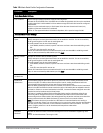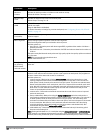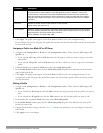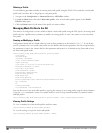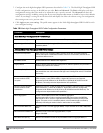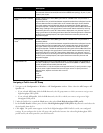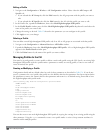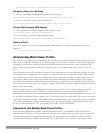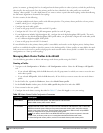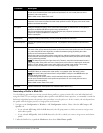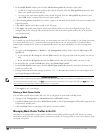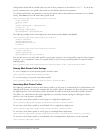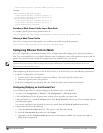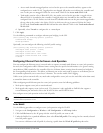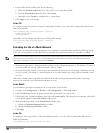
ap mesh-ht-ssid-profile <profile-name> clone <source-profile-name>
Assigning a Profile to an AP Group
To associate a mesh high-throughput SSID profile with an AP group:
(host)(config) #ap-group <group> mesh-ht-ssid-profile <profile-name>
To associate a mesh radio profile with an individual AP:
(host)(config) #ap-name <name> mesh-ht-ssid-profile <profile-name>
Viewing High-throughput SSID Settings
To view a complete list of high-throughput profiles and their status:
(host)(config) #show ap mesh-ht-ssid-profile
To view the settings of a specific high-throughput profile:
(host)(config) #show ap mesh-ht-ssid-profile <profile-name>
Deleting a Profile
If no AP or AP group is using a mesh high-throughput SSID profile, you can delete that profile using the no
parameter:
no ap mesh-ht-ssid-profile <profile-name>
Understanding Mesh Cluster Profiles
The mesh cluster configuration gets pushed from the controller to the mesh portal and the other mesh points, which
allows them to inherit the characteristics of the mesh cluster of which they are a member. Mesh nodes are grouped
according to a mesh cluster profile that contains the MSSID, authentication methods, security credentials, and
cluster priority. Cluster profiles, including the “default” profile, are not applied until you provision your APs for
mesh.
Since the mesh cluster profile provides the framework of the mesh network, you must define and configure the mesh
cluster profile before configuring an AP to operate as a mesh node. You can use either the “default” cluster profile or
create your own. If you find it necessary to define more than one mesh cluster profile, you must assign priorities to
each profile to allow the Mesh AP group to identify the primary and backup mesh cluster profile(s). The primary
mesh cluster profile and each backup mesh cluster profile must be configured to use the same RF channel. The APs
may not provision correctly if they are assigned to a backup mesh cluster profile with a different RF channel than the
primary mesh cluster profile.
If the mesh cluster profile is unavailable, the mesh node can revert to the recovery profile to bring-up the mesh
network until the cluster profile is available. You can also exclude one or more mesh cluster profiles from an
individual AP—this prevents a mesh cluster profile defined at the AP group level from being applied to a specific AP.
Do not delete or modify mesh cluster profiles once you use them to provision mesh nodes. You can recover the mesh
point if the original cluster profile is still available. Dell recommends creating a new mesh cluster profile if needed. If
you modify any mesh cluster setting, you must reprovision your AP for the changes to take effect (this also causes
the AP to automatically reboot). See “Provisioning Mesh Nodes” for more information.
Deployments with Multiple Mesh Cluster Profiles
If you configure multiple cluster profiles with different cluster priorities, you manually override the link metric
algorithm because the priority takes precedence over the path cost. In this scenario, the mesh portal uses the profile
with the highest priority to bring-up the mesh network. The mesh portal stores and advertises that one profile to
neighboring mesh nodes to build the mesh network. This profile is known as the “primary” cluster profile. Mesh
DellPowerConnectW-SeriesArubaOS6.2 | User Guide SecureEnterpriseMesh | 459



